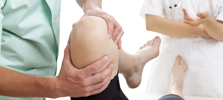Scoliosis
Scoliosis is a term which describes a curvature of the spine. Although there are many causes for a curvature of the spine, the vast majority of curvatures are termed idiopathic curvatures, a word which means essentially that there is no cause for the curvature. Again, the vast majority of the cases of scoliosis which we see occur in the pre-adolescent age group.
These are not caused by injuries, and these curvatures basically represent a condition in which there is a developmental growth abnormality of the spine in which a curvature developed. Within the past fifteen years, it has been determined that heredity plays the greatest role in so far as the cause of the curvature. Curvatures often times occur in more than one child in the family, or if only one child in the family has a curvature, the curvature is often noted in a relative, and not necessarily an immediate relative.
Curvatures must be measured by x- rays. We measure the curvature in degrees. Most curvatures need only observation. As long as a curvature does not increase, and as long as a curvature has not progressed to a significant degree, a curvature is only observed. Only surgery can reverse a curvature, and surgery is not indicated unless the curvature exceeds fifty five degrees. In these instances, surgery is recommended in order to prevent the complications which occur in adulthood on the basis of the curvature. It has been determined from studies of large populations that curvatures below this approximate figure do not cause significant difficulties during childhood, and present basically with a problem of cosmesis.
A brace, such as the Milwaukee or the Boston brace, does not reverse a curvature. A brace is capable only of preventing progression of a curvature. Therefore, if a curvature is not progressing, we will not recommend a brace.
Our goal is to asses the curvature from the standpoint of whether it is the type of curvature which may cause difficulties duing adulthood. Most curvatures under fifty degrees are not affected by pregnancy, and do not cause adults major difficulties as they age. We recognize the psychological trauma that occurs by placing an adolescent in any sort of a brace, and we adhere to strict indications that a brace is only recommended for that curvature which indicates that it is definitely on the increase.
Our ordinary program consists of observation on a six month basis. If a curvature is highly suspicious, the period of observation might be on a more frequent basis. We are aware of the concern regarding exposure to radiation, and we prefer to avoid it if we are absolutely certain that we can judge the curvature by physical examination. This is usually not the case. Be assured that large populations of scoliosis patients have been evaluated in terms of their exposure to radiation, and they carry no higher incidence of a radiation associated problems in comparison with the normal population.
Exercise will not ordinarily increase or decrease the tendency towards a curvature. We rely on exercise for situations in which we determine that the back pain which a person experiences might be based on weakness, and we also rely on exercise in situations where the person has been instructed to wear a brace.
The use of electrical stimulation has been publicized in the news media. This is presently experimental and is not universally available in our country. As innovation occurs, we become aware of these through our continuing medical education and will implement innovations when they have been released by the Federal Controls for use in all situations.
In summary, scoliosis represents aberration which occurs usually on a hereditable basis, is usually not associated with pain, and ordinarily can be followed with periodic observation. Surgical treatment is indicated only for the curvature that has progressed in a certain degree and a brace is used only in curvatures which indicate that they are increasing.


